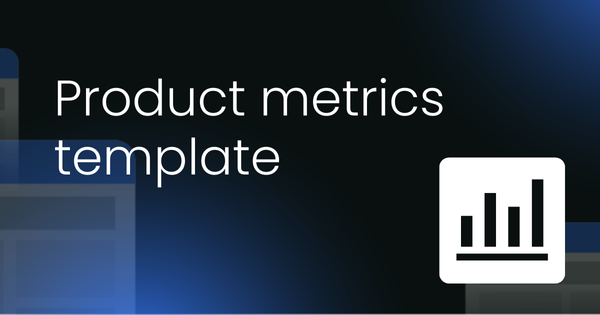Ever wonder how to measure customer retention?
You’ve got a killer product, and you’re constantly growing your business like a pro. But just how much value are you getting from your users? What metrics should you focus on to understand if they’re sticking around, and how do you measure that loyalty?
The analytics of it all can be dizzying, but the benefits from tracking it are well worth it.
We’ve got the 10 most important metrics for measuring customer retention, all organized in one neat list. So, settle down, get your learning cap on, and let’s get to it!

Customer Retention Rate (CRR)
Perhaps the most vital metric we’ll look at, customer retention rate (CRR) is the number of customers who still do business with you after a given period of time. Understanding this metric is one of your best customer loyalty indicators and a gauge of how well your strategy is working.
How to calculate customer retention rate
To calculate CRR, you need to gather three pieces of data: (1) the number of customers you had at the beginning of the reporting period, (2) the total number of customers at the end of the period, and (3) the number of customers you acquired during the reporting period.
Once you have your data, it's time to calculate. To do this, start by subtracting the number of new customers acquired (E) from the total number of customers at the end of the period (N). Next, divide that number by the amount of customers recorded at the beginning of the reporting period (S). Finally, multiply by 100.
Don’t underestimate the power of an existing customer base. Keeping your current customers happy makes them more likely to refer your services to others. This is essentially free marketing for doing what you do best, providing a quality product others can’t wait to share.
Monthly Churn Rate
Churn rate is the amount of business you’ve lost in any given time period. Most companies review this metric monthly. It’s a great time period to offer a snapshot of your customer’s behaviors, allowing you to track it over the year and see which business decisions are working for you or aren’t.
Monthly churn rate is calculated by dividing the number of customers lost at the end of the month by the total number of customers at the start of the month, multiplied by a hundred.
Your ultimate goal should be to reduce the churn rate. If you have a high volume of customers leaving, this is a clear sign you need to reevaluate your product or the expectations you’ve set for it. An average church rate should be around 5-15%. Focusing on churn rate also allows you to predict revenue loss, so be savvy with this metric.
Revenue Churn Rate
This metric isn’t to be confused with customer churn rate. Revenue churn focuses on the amount of money you’ve lost in a given time period. This offers much more context than customer churn. It’s no longer how many customers you’re losing but what type of customer you’ve lost. Losing any client is bad, but losing a client with high value is far worse.
Remember when we spoke about how costly bringing in a new customer is? Don’t give your loyal ones a reason to leave. Your ROI will go up in smoke.
Revenue churn offers insight into your pricing system. If your product has tiered pricing, this metric lets you see where people are downgrading or canceling their plans. If revenue churn is high, now is the time to play around with your pricing strategy. Maybe the jump between tiers is too big? Maybe your packages don’t include enough to entice customers to make the leap to the next. Get creative and see what works for you.
Repeat Purchase Ratio
At this point, you’ve nailed why if you’re losing customers and have course corrected because you’re a pro. Now it’s time to track how often those customers are flocking back to you and turning into repeat clients.
Repeat Purchase Ratio is another loyalty indicator that can be tracked to best fits your product. It can be calculated by dividing the number of returning customers by your total customers. You want to aim for 20-40%, which means healthy growth.
Keep in mind this is a compounding metric. A customer who only repeats a purchase once isn’t as valuable as someone who returns multiple times. Each industry will also vary depending on if the product is seasonal or high value. These products aren’t purchased as often, so set your expectations accordingly.
Repeat Purchase Ratio is a very actionable metric because it highlights customers' spending habits, which you can then tailor your marketing around. Notice people tend to buy your products every three to four months? Send them a newsletter at the two-month mark to get the idea of purchasing the product sooner on their mind.
Purchase Frequency
Purchase frequency is not to be confused with Repeat Purchase Ratio. Stay with me, folks.
While Repeat Purchase Ratio is the percentage of customers who’ve made more than one purchase, Purchase Frequency is the number of times a customer buys in a certain period. This is calculated by dividing the number of customers who have bought more than once by the total number of customers over a given time.
You can go even further and look at Time Between Purchase to understand your customers purchasing behavior to use to your advantage. Maybe they aren’t buying as often as you’d like? This could be a sign to increase your email campaigns or incentivize spending through rewards programs.
A high Purchase Frequency indicates sustainable growth, gives you better insights for future campaigns, and can help you anticipate customer buying needs.
Product Return Ratio
We’re taking the focus off the customer for just a bit to focus on your product. Although it does tie back into customer retention, I promise!
Product Return Ratio measures the rate at which products are returned. Ideally, you would get this number to zero. Realistically, this number hovers around 9-20%. If your number is high, now is the time for damage control and to see where you need to improve your product.
To calculate, you need the number of units sold that were returned divided by the total number of units sold. If one product is being returned more than another, now you know your customer’s preferences and where to put your focus.
To reduce returns, outside of having the best product ever, make sure you’re setting your customer’s expectations up correctly. Don’t falsely advertise because you will disappoint the customer, who will likely return the product, and maybe even leave you a bad review. 23% of returned products were because the description didn’t match what customers bought, s don’t fall into this easily avoidable trap!
Net Promoter Score (NPS)
Customer loyalty and satisfaction can be measured through NPS. This metric is how likely a customer is to recommend a product and can be achieved with surveys. Who doesn’t love a good survey?
Have you had the deepest desire to ask your customers how likely they’d rate or recommend your product on a scale of 1-10? Now’s your chance. And you don’t have to stop there. The more specific you get with your questions in this survey, the better data you’ll have to tailor your products. Ask those follow-up questions about demographics, the quality of the product, and even why a customer would recommend it. The more you know, the better you can understand your NPS.
Once you have your NPS, you can use it as an indicator to predict company growth. High NPS means you’re more likely to have good word of mouth, and that’s advertising you didn’t have to pay for.
All you need to calculate your NPS is software to run the surveys, a few good questions to put you on the right path, and a product people just can’t resist. The rest is history.
Customer Lifetime Value (CLV)
Curious how much a customer will net you over their entire relationship with your business? Me too! Calculating CLV is a long-term metric showing how much you can afford to onboard a customer. It’s basically the longevity you get from that customer.
CLV is distinct from NPS because it measures revenue, not just the promise of loyalty. The longer a customer is with you, the more value they bring to that lifecycle, so improving CLV is a must. It also gives you better forecasting for revenue, though it can be hard to measure if you don’t break down the data into smaller pieces.
Many factors can influence a customer’s buying habits, so don’t lose sight of that when considering CLV for business decisions. Remember to look at the location, customer size, demographics, and much more. To do this, you want to target your ideal customers and reduce acquisition costs. Test strategies for easy onboarding and get the most value from your customers.
Expansion MMR
Cross-sells, upsells, add-ons, and reactivations. What do these all have in common? They can be tracked under Expansion MMR. That’s additional revenue a product makes after initial onboarding.
Expansion MMR is tracked monthly and is a great indicator if your customers are receiving value from products. It even tells you if those products are creating demand. As a bigger-picture metric, Expansion MMR can inform retention efforts and whether your current strategy is working. Let’s look at the four types of expansions you can try if it’s not!
- Cross-sells are when customers buy additional products to the one they initially purchased. Usually, these products are complementary and benefit each other, enticing the customer to buy the other.
- Add-ons are when customers purchase additional features for a product they already own. These features enhance that specific product’s experience and are usually small purchases or can be reoccurring.
- Up-sells are when a customer opts for a pricier version of a product.
- Reactivation is when a customer previously canceled a subscription and then renews it.
When customers dive into these types of expansions, it shows they are receiving high value from your product, and demand is being generated. Jump while the iron is hot and show how much more you can give your clients!
Customer Satisfaction Score (CSAT)
Another one for the surveys and very similar to NPS. You’re looking for overall satisfaction with this metric, usually on a scale of 1-10. Some companies even use emojis to rate the customer experience. Whatever works for the tone of your business!
This quantitative measurement for qualitative feedback can show whether you’re meeting customer expectations. Feel free to ask additional questions to really hone responses and see where you need improvement, or better yet, keep smashing on!
The best way to deliver surveys is through websites, email campaigns, and kiosks if your product is in-store. Make sure you’re timing your surveys right because oversaturating your customers can cause them to pull back. You want to make sure their voice is heard, not being dragged out of them after every interaction.
One thing to be wary of with CSAT is that happy customers don’t always equal long-term clients. So, don’t just sleep on a good survey response. Continually push your products to be the best they can be!
Conclusion
Measuring customer retention is a multifaceted approach, but now you have some tools to keep your clients happy and around for a long, long time. And if that isn’t the goal of good business, I don’t know what is. So, retain those customers you worked so hard to acquire! You deserve it, after all. 😊



 Follow us on LinkedIn
Follow us on LinkedIn




